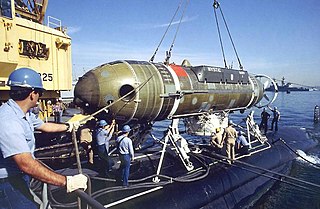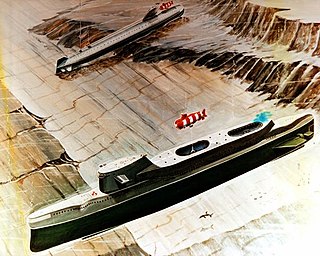
The Gulf of Finland is the easternmost arm of the Baltic Sea. It extends between Finland to the north and Estonia to the south, to Saint Petersburg in Russia to the east, where the river Neva drains into it. Other major cities around the gulf include Helsinki and Tallinn. The eastern parts of the Gulf of Finland belong to Russia, and some of Russia's most important oil harbors are located farthest in, near Saint Petersburg. As the seaway to Saint Petersburg, the Gulf of Finland has been and continues to be of considerable strategic importance to Russia. Some of the environmental problems affecting the Baltic Sea are at their most pronounced in the shallow gulf. Proposals for a tunnel through the gulf have been made.

The Russian Navy is the naval arm of the Russian Armed Forces. It has existed in various forms since 1696; its present iteration was formed in January 1992 when it succeeded the Navy of the Commonwealth of Independent States.

Mystic class is a class of Deep-Submergence Rescue Vehicles (DSRVs), designed for rescue operations on submerged, disabled submarines of the United States Navy or foreign navies. The two submarines of the class were never used for this purpose, and were replaced by the Submarine Rescue Diving Recompression System.

The Project 940 Lenok class was a military submarine design of the Soviet Union.

The Black Sea Fleet is the fleet of the Russian Navy in the Black Sea, the Sea of Azov and the Mediterranean Sea. The Black Sea Fleet, along with other Russian ground and air forces on the Crimean Peninsula, are subordinate to the Southern Military District of the Russian Armed Forces.

The Baltic Fleet is the fleet of the Russian Navy in the Baltic Sea.

A deep-submergence rescue vehicle (DSRV) is a type of deep-submergence vehicle used for rescue of downed submarines and clandestine missions. While DSRV is the term most often used by the United States Navy, other nations have different designations for their vehicles.

Nord Stream is a pair of offshore natural gas pipelines in Europe that run under the Baltic Sea from Russia to Germany. It comprises the Nord Stream 1 (NS1) pipeline running from Vyborg in northwestern Russia, near Finland, and the Nord Stream 2 (NS2) pipeline running from Ust-Luga in northwestern Russia near Estonia. Both pipelines run to Lubmin in the northeastern German state of Mecklenburg-Vorpommern. Each pipeline comprises two pipes, denoted A and B; each of the four pipes is approximately 1,200 kilometres (750 mi) long and with approximate diameters of 1,220 millimetres (48 in). The combined capacity of the four pipes is 110 billion cubic metres per annum of natural gas.

The Steregushchiy class, Russian designation Project 20380, is a class of corvettes being built for the Russian Navy. Designed by the Almaz Central Marine Design Bureau, subsequent vessels were built to an improved design, incorporating the Zaslon-Redut SAM system. The ship full displacement and dimensions are large for a corvette, thus it is designated as a frigate by NATO. The Steregushchiy class has been further developed into the Gremyashchiy class and Project 20386 subclasses. The export variant is known as Project 20382 Tigr.
The Type 925 Dajiang with NATO reporting name Dajiang, or 大江 in Chinese, meaning Great River, is a type of naval auxiliary ship belonging to the People's Republic of China. Each ship is usually equipped with up to two Type 7103 DSRV class Deep Submergence Rescue Vehicles (DSRVs). The ship is designed to replace the first People's Liberation Army Navy (PLAN) submarine tender PLANS Mount Tai, and the lead ship of the Dajiang class is the Changxingdao. The Type 925 is a submarine tender that can also be used as a submarine rescue ship, and hence, it is designated as a submarine support ship by Chinese.

BALTOPS is an annual military exercise, held and sponsored by the Commander, United States Naval Forces Europe, since 1971, in the Baltic Sea and the regions surrounding it.
The People's Republic of China developed a class of 35-ton deep-submergence rescue vehicle (DSRV) for the People's Liberation Army Navy (PLAN). It was first tested in 1986 and operational in 1989.

The Cheonghaejin class is a submarine rescue ship class of the Republic of Korea Navy. Only one ship has been built in the class, ROKS Cheonghaejin, in 1995. Its operations include rescuing trapped sailors in submarines, naval operation support for submarines, underwater research and mapping support, and recovery of sunk vessels. It is equipped with a deep submergence rescue vehicle (DSRV) that operates up to 500 metres (1,600 ft), and a rescue chamber that holds up to nine people.

The Pacific Fleet is the Russian Navy fleet in the Pacific Ocean.

Kommuna is a submarine salvage ship in service with the Russian Navy's Black Sea Fleet and the world's oldest active duty naval vessel. A double-hulled catamaran, she was laid down at the Putilov Factory in St. Petersburg in November 1912 as Volkhov. The ship was launched the following year, and commissioned on 14 July 1915. She was renamed Kommuna on 31 December 1922. Kommuna has served in the Russian Imperial, Soviet, and Russian Federation navies through the Russian Revolution and two World Wars.

Nord Stream 2 is a 1,234-kilometre-long (767 mi) natural gas pipeline from Russia to Germany running through the Baltic Sea, financed by Gazprom and several European energy companies. The construction of the pipeline started in 2011, to expand the Nord Stream 1 line and double annual capacity to 110 billion cubic metres. It was completed in September 2021, but has not yet entered service. Planning and construction of the pipeline were mired in political controversy over fears that Russia would use it for geopolitical advantage with Europe and Ukraine.
Submarine rescue is the process of locating a sunk submarine with survivors on board, and bringing the survivors to safety. This may be done by recovering the vessel to the surface first, or by transferring the trapped personnel to a rescue bell or deep-submergence rescue vehicle to bring them to the surface. Submarine rescue may be done at pressures between ambient at depth, and sea level atmospheric pressure, depending on the condition of the distressed vessel and the equipment used for the rescue. Self-rescue of submarine personnel by buoyant free ascent at ambient pressure is considered submarine escape. Survivors may require recompression treatment for decompression illness.

On 26 September 2022, a series of clandestine bombings and subsequent underwater gas leaks occurred on the Nord Stream 1 and Nord Stream 2 natural gas pipelines. Both pipelines were built to transport natural gas from Russia to Germany through the Baltic Sea, and are majority owned by the Russian majority state-owned gas company, Gazprom. The perpetrators' identities and the motives behind the sabotage remain debated.

The Project 141, is a class of salvage vessel/submersible support built at Rostock's Neptun Werft in East Germany for the Soviet Navy.


















